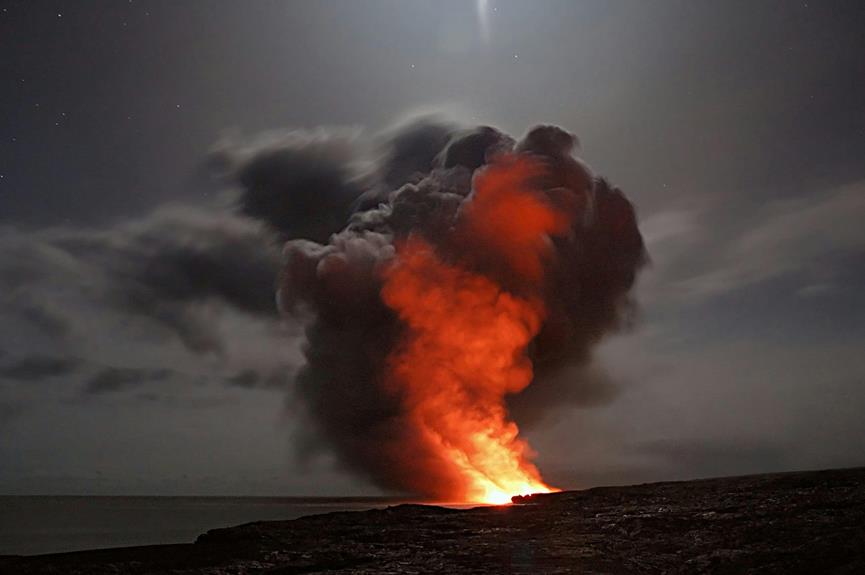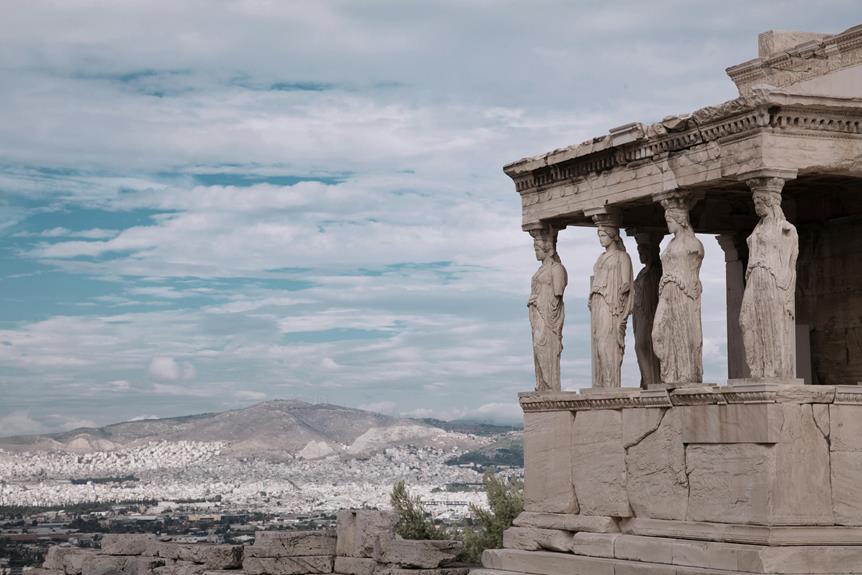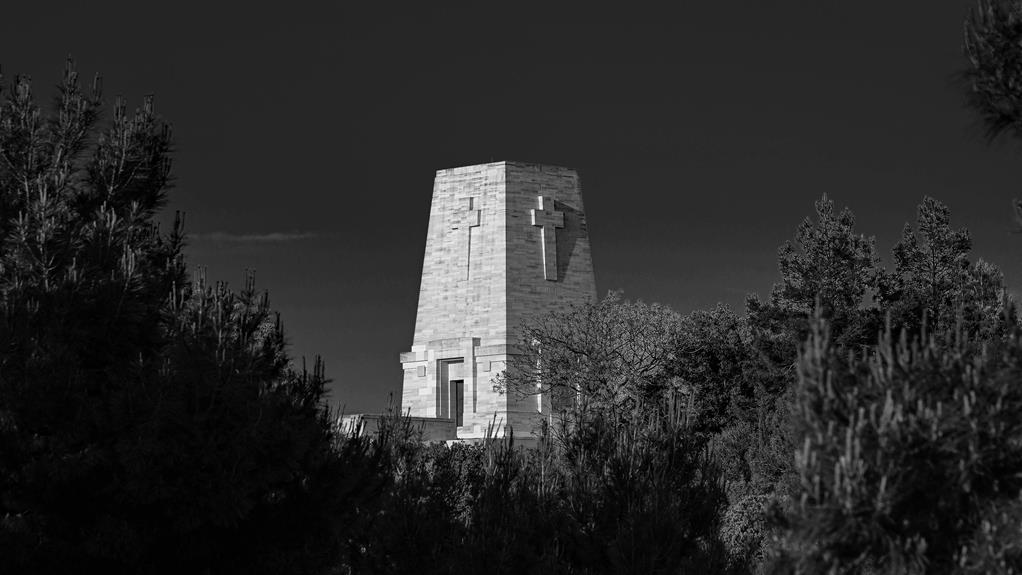Mount Vesuvius, standing stoically near Naples, Italy, holds an intriguing blend of geological wonder and historical tragedy. Beyond its infamous eruption in 79 AD that froze Pompeii in time, Vesuvius maintains an aura of unpredictability with its ongoing volcanic activity. The juxtaposition of beauty and danger makes this site a compelling subject for further exploration. From the remnants of ancient civilizations to the modern-day monitoring efforts, Mount Vesuvius beckons us to uncover its secrets and complexities, offering a glimpse into both the past and the future.
Key Takeaways
- Historic eruption in 79 AD buried Pompeii.
- Ongoing volcanic activity monitored for hazards.
- Panoramic views attract visitors to hike.
- Excavations reveal insights into ancient life.
- Conservation efforts focus on sustainability.
Historical Eruption of 79 AD
The cataclysmic eruption of Mount Vesuvius in 79 AD forever altered the landscape of the surrounding region and left a lasting mark on the course of history. An impact assessment of this eruption reveals the immense devastation caused by the volcano's violent outburst. The city of Pompeii, located at the foothills of Vesuvius, was buried under meters of volcanic ash and pumice, preserving a snapshot of ancient Roman life for centuries to come.
Archaeological findings from the ruins of Pompeii have provided invaluable insights into daily life in the Roman Empire. The meticulous preservation of buildings, artifacts, and even human remains has allowed researchers to piece together a detailed picture of the society that existed at the time of the eruption. From intricate frescoes and mosaics to everyday utensils and tools, the excavations at Pompeii continue to yield new discoveries that shed light on the customs, beliefs, and technologies of the ancient world.
The eruption of Mount Vesuvius in 79 AD serves as a stark reminder of the power and unpredictability of volcanic activity. By studying the impact of this catastrophic event through archaeological evidence, scientists and historians can better understand the long-term consequences of such natural disasters on human populations and the environment. The lessons learned from Mount Vesuvius continue to inform modern-day strategies for disaster preparedness and risk mitigation in volcanic regions around the world.
Geological Formation and Structure
Mount Vesuvius, situated in Italy, exhibits a complex geological formation and structure characterized by its volcanic origins and distinct features. The formation process of Mount Vesuvius can be attributed to the subduction of the African tectonic plate beneath the Eurasian plate. This subduction zone has led to the melting of rock materials in the Earth's mantle, creating magma chambers that eventually lead to volcanic eruptions.
The structure of Mount Vesuvius is composed of layers of hardened lava, volcanic ash, and pumice, which have accumulated over the years through various eruptions. These layers form a stratovolcano, known for its steep slopes and conical shape. The magma beneath the surface interacts with groundwater, leading to phreatic eruptions caused by the sudden release of steam and volcanic gases.
Moreover, the geological composition of Mount Vesuvius includes minerals such as olivine, pyroxene, and plagioclase, indicating its basaltic to andesitic nature. The presence of these minerals influences the volcano's eruptive behavior and the type of lava it produces during volcanic events.
Ongoing Volcanic Activity
Amidst the dynamic geological landscape of Mount Vesuvius in Italy, ongoing volcanic activity continues to shape the surrounding environment. Current monitoring of Mount Vesuvius is essential due to its history of destructive eruptions, such as the infamous AD 79 eruption that buried the Roman cities of Pompeii and Herculaneum. Scientific research plays a vital role in understanding the behavior of this active volcano and predicting potential future eruptions.
Volcanic monitoring techniques at Mount Vesuvius include seismometers to detect ground tremors, gas analyzers to measure the composition of volcanic gases, and GPS instruments to monitor ground deformation. These tools provide scientists with valuable data to assess the volcano's activity levels and make informed decisions regarding public safety.
Scientific research at Mount Vesuvius focuses on studying the magma chamber beneath the volcano, the dynamics of volcanic eruptions, and the factors that influence eruption patterns. By analyzing past eruptions and geological data, researchers can develop models to forecast potential volcanic hazards and establish evacuation plans for at-risk areas.
Continued monitoring and research are essential to mitigating the risks posed by Mount Vesuvius. By staying vigilant and proactive, scientists can better understand this volatile volcano and help protect the lives and properties of those living in its vicinity.
Impact on Pompeii and Herculaneum
Continuously impacted by the volcanic activity of Mount Vesuvius, the ancient Roman cities of Pompeii and Herculaneum serve as poignant reminders of the catastrophic events that unfolded in AD 79. Excavation discoveries and archaeological findings in these cities have provided valuable insights into the daily lives of the ancient inhabitants and the devastating effects of the eruption.
The excavation of Pompeii, beginning in the 18th century, revealed a remarkably preserved city frozen in time by layers of volcanic ash and pumice. Buildings, artifacts, and even plaster casts of the victims offer a glimpse into the urban layout, social structure, and cultural practices of the Pompeiian society. Similarly, Herculaneum, located closer to the volcano, was also engulfed by the eruption but buried under a different type of material, allowing for the conservation of wooden structures and organic remains not typically found in Pompeii.
Archaeological findings in both cities have illuminated aspects of ancient Roman life, including architectural styles, economic activities, religious practices, and social norms. The meticulous documentation of these discoveries has facilitated the reconstruction of the events leading up to the eruption and the subsequent chaos that ensued. Through ongoing excavations and research, scholars continue to unravel the mysteries of Pompeii and Herculaneum, shedding light on the profound impact of Mount Vesuvius on these ancient settlements.
Breathtaking Panoramic Views
From elevated vantage points surrounding the ancient cities of Pompeii and Herculaneum, visitors are treated to breathtaking panoramic views that showcase the stunning landscape of the region. Mount Vesuvius offers a unique perspective of the Bay of Naples, with its azure waters contrasting against the verdant slopes and the picturesque towns below. The interplay of light and shadow as the sun sets creates a mesmerizing display for sunset photography enthusiasts, casting a warm glow over the entire scene.
For those seeking a more active experience, Mount Vesuvius boasts a network of well-maintained hiking trails that lead to various viewpoints along the crater rim. These trails not only provide opportunities for exercise and exploration but also offer uninterrupted vistas of the surrounding countryside. Hikers can witness the rugged beauty of the volcanic terrain up close, with the distant outline of the Sorrento Peninsula and the islands of Capri and Ischia visible on clear days.
The panoramic views from Mount Vesuvius encapsulate the rich history and natural splendor of the region, making it a must-visit destination for travelers looking to immerse themselves in the beauty of southern Italy. Whether capturing the magic of a sunset or undertaking a rewarding hike, visitors are sure to be captivated by the unparalleled scenery that unfolds before them.
Tourism and Visitor Experience
With a focus on enhancing the overall visitor experience, tourism at Mount Vesuvius is meticulously curated to provide insight into the geological and historical significance of the region. Visitor safety is paramount, with designated pathways and viewing areas ensuring that guests can explore the volcano safely while enjoying panoramic views of the Bay of Naples. Additionally, amenities such as visitor centers, guided tours, and educational exhibits contribute to a well-rounded experience for all guests.
Sustainable tourism practices are integral to preserving Mount Vesuvius for future generations. Efforts are made to minimize the environmental impact of visitors through waste management programs and eco-friendly initiatives. By promoting responsible tourism, the delicate ecosystem surrounding the volcano is safeguarded, allowing both the natural beauty and scientific value of the area to endure.
Preservation efforts extend beyond environmental concerns to include the historical and cultural significance of Mount Vesuvius. Interpretive signage and educational programs educate visitors about the volcano's role in shaping the landscape and its impact on the surrounding communities throughout history. By fostering an appreciation for the region's heritage, tourism initiatives contribute to the ongoing preservation of Mount Vesuvius as a cultural landmark of global importance.
Conservation Efforts and Monitoring
Efforts to conserve Mount Vesuvius and monitor its volcanic activity are vital components of safeguarding both the natural environment and the surrounding communities. The conservation of Mount Vesuvius involves a combination of environmental protection measures and research initiatives aimed at better understanding the volcano's behavior and potential risks.
Here are three key aspects of the conservation efforts and monitoring strategies in place:
- Environmental Protection: Conservation efforts on Mount Vesuvius focus on preserving the unique ecosystem surrounding the volcano. This includes initiatives to prevent deforestation, protect wildlife habitats, and ensure the sustainability of the flora and fauna in the region. By maintaining the natural environment, researchers can also monitor any changes that might indicate volcanic activity.
- Research Initiatives: Scientists conduct ongoing research to study the geological processes at work within Mount Vesuvius. This research helps in predicting potential eruptions and understanding the behavior of the volcano. By analyzing data on seismic activity, gas emissions, and ground deformation, researchers can assess the volcano's current state and potential hazards.
- Technology and Early Warning Systems: Advanced technological systems, such as seismometers, GPS sensors, and gas monitoring devices, are employed to provide early warnings of volcanic activity. These systems help authorities issue timely alerts to nearby communities, allowing for evacuation procedures to be implemented swiftly and effectively. Continuous monitoring through technology is crucial for ensuring the safety of residents living in the vicinity of Mount Vesuvius.
Vesuvius in Popular Culture
The enduring presence and historical significance of Mount Vesuvius have inspired various cultural representations and depictions in popular media and artistic works. This active volcano, known for its catastrophic eruption in 79 AD that buried the Roman cities of Pompeii and Herculaneum, has captured the imagination of people across the globe, leading to numerous pop culture references and artistic interpretations.
One notable pop culture reference to Mount Vesuvius is its appearance in the lyrics of songs such as "Pompeii" by Bastille, which reflects on the tragic events that befell the ancient city. Additionally, the volcano has been featured in movies like "Pompeii" (2014), where its eruption serves as a backdrop for a dramatic love story. Furthermore, various TV shows and documentaries have explored the history and impact of Vesuvius, bringing its story to a wider audience.
To delve into the artistic interpretations of Vesuvius, let's consider the following table that showcases different ways in which this iconic volcano has been depicted in popular culture:
| Artistic Interpretations | Description | Emotion evoked |
|---|---|---|
| Paintings | Artists have captured the volcano's power and destruction in vivid colors and dramatic compositions | Awe and fear |
| Literature | Writers have woven tales of tragedy and resilience around Vesuvius, highlighting its impact on human history | Melancholy and courage |
| Sculptures | Sculptors have crafted intricate models and statues of Vesuvius, showcasing its grandeur and danger | Reverence and caution |
Through these diverse pop culture references and artistic interpretations, Mount Vesuvius continues to be a symbol of both natural beauty and catastrophic power in the collective imagination.
Frequently Asked Questions
Can Mount Vesuvius Erupt Without Warning?
Volcanic eruptions, including those of supervolcanoes like Yellowstone, can occur without immediate warning due to the complex nature of volcanic systems.
Volcanic monitoring, seismic activity analysis, and disaster preparedness are vital for early detection of potential eruptions.
Emergency evacuation plans must be in place to safeguard lives in case of sudden volcanic activity.
Proactive measures, such as continuous monitoring and public awareness campaigns, are essential for minimizing the impact of volcanic disasters.
How Has Mount Vesuvius Influenced Italian Cuisine?
Italian cuisine has been heavily influenced by the culinary traditions and cultural impact of Mount Vesuvius. The volcanic soil around the mountain provides fertile grounds for growing flavorful ingredients like San Marzano tomatoes and Vesuvian apricots.
The rich minerals in the soil enhance the taste of local produce, shaping traditional dishes like Neapolitan pizza and pasta alla puttanesca. This unique environment has played a significant role in defining the gastronomic identity of Italy.
Are There Any Ancient Artifacts Still Buried in Pompeii?
Archaeological discoveries continue to be unearthed in Pompeii, reflecting the rich historical preservation and cultural significance of this ancient city.
Ongoing excavations reveal a plethora of ancient artifacts still buried beneath the ash.
These findings provide valuable insights into the daily lives, customs, and architecture of the residents of Pompeii, allowing for a deeper understanding of this remarkable civilization and its contributions to history.
What Measures Are in Place to Protect Nearby Residents?
In regions prone to natural disasters, such as volcanic eruptions, safeguarding residents is paramount. Emergency shelters play a vital role in providing refuge, while evacuation routes offer a means of swift escape.
These measures are meticulously planned and regularly reviewed to guarantee their effectiveness in protecting lives and minimizing damage. By strategically placing shelters and optimizing evacuation routes, authorities aim to enhance the safety and well-being of nearby residents in times of crisis.
Is It Safe to Hike to the Summit of Mount Vesuvius?
When considering the safety of hiking to the summit of a volcano, it is essential to evaluate the implementation of safety precautions and the efficacy of volcanic monitoring systems. These measures play a pivotal role in ensuring the well-being of individuals venturing to such areas.
Conclusion
To summarize, Mount Vesuvius in Italy stands as a proof of the powerful forces of nature, with its historical eruption in 79 AD leaving a lasting impact on the surrounding region.
Ongoing volcanic activity, coupled with conservation efforts and monitoring, underscores the importance of sustainable practices in preserving this geological wonder.
Despite its tumultuous past, Mount Vesuvius continues to attract visitors with its stunning views and rich history, making it an intriguing destination for exploration.


